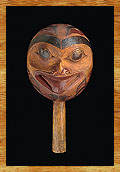 
(Page 2 of 2) |
Skedans
The inhabitants of Haida villages like Skedans probably traded several thousand objects to travellers; of these, perhaps one thousand are now in museums, but only a few score have been specifically documented as to their village of origin. Dawson made interesting observations about how the trade in curios took place:
Besieged by Indians with various things to sell this morning, curiosities, new potatoes about the size of wallnuts . . . Soon after dark Capt Klue & three of his people arrived, disgusted that they had not been knowing enough to offer items for Sale when we were [in] their country, & having heard that Skedan was making a big thing out of us. Brought with them one remarkable mask with a nose about 6 feet long, a dancing pole highly prized & gaily painted & a head ornament composed of a cedar bark ring into which a great number of imitation arrows, in wood & feathered, were stuck. All these they valued much & had evidently brought their best things to cut out Skedan & his friends.

 |
One side of this shaman's rattle portrays a Bear with an extended tongue. The other side has the face of Hawk.
Collected from Skedans in 1897 by Charles F. Newcombe.
CMC VII-B-544 (S92-4238) |

The village of Skedans has a special aura it presents even to contemporary visitors. Robert Bruce Inverarity, an art historian, collector and museum director, visited the site in 1932 and describes his impressions:
Last night I thought I heard voices in the wind and at first thought the sealers had landed on the beach. But then when I heard women's voices thought perhaps a party had come from Skidegate, but when the voices came no closer and drifted no farther away, I knew I was wrong. They all seemed to be singing. The men's voices were low and the women's voices were very high and sustained. I got up and gazed at the beach,-- there was no sign of anyone. In the morning I looked at the beach but could find no sign of any boat having landed. Later I learned that other people had also heard ghosts here and when I described the singing to some old Indians, they told me that it was a funeral dirge I had heard.
|